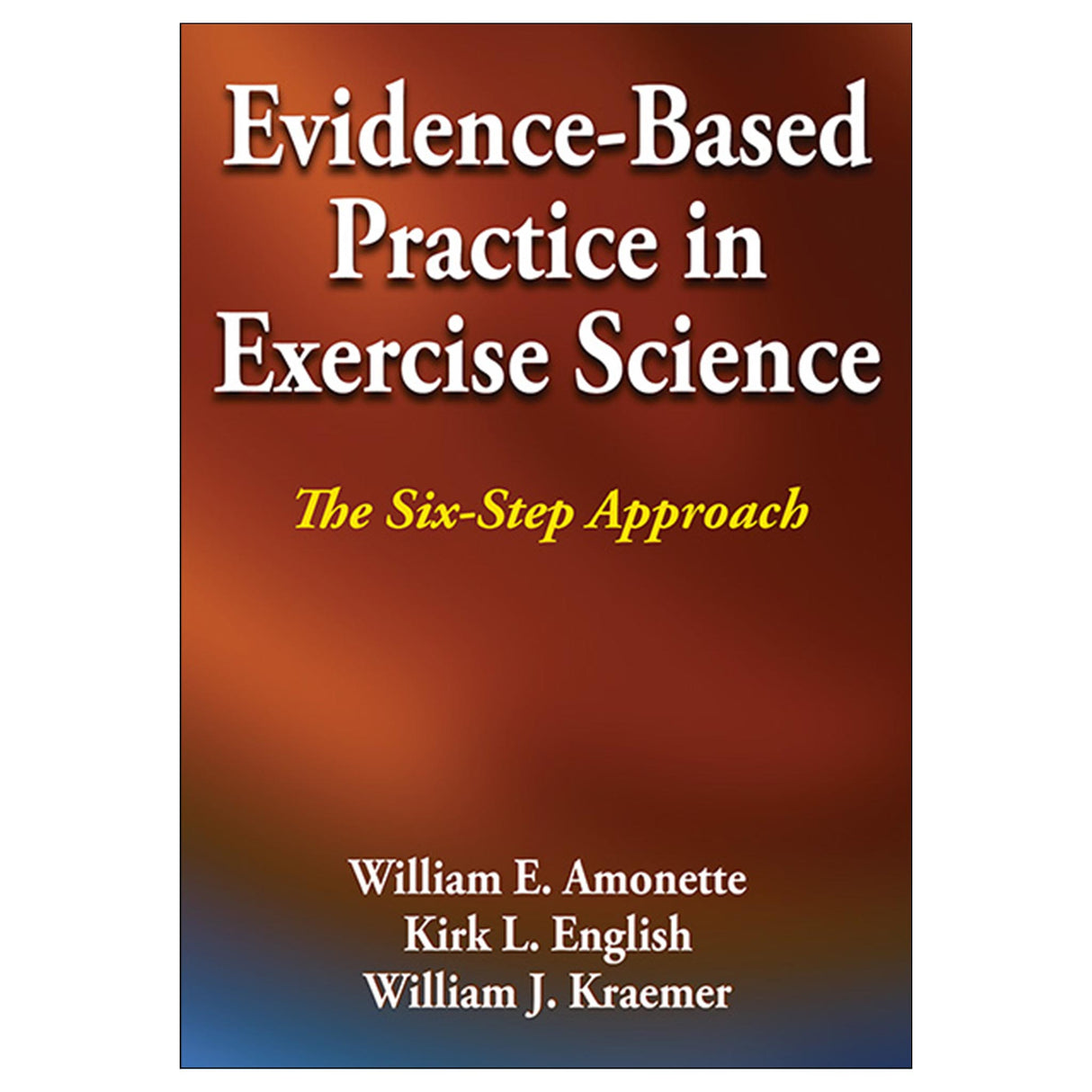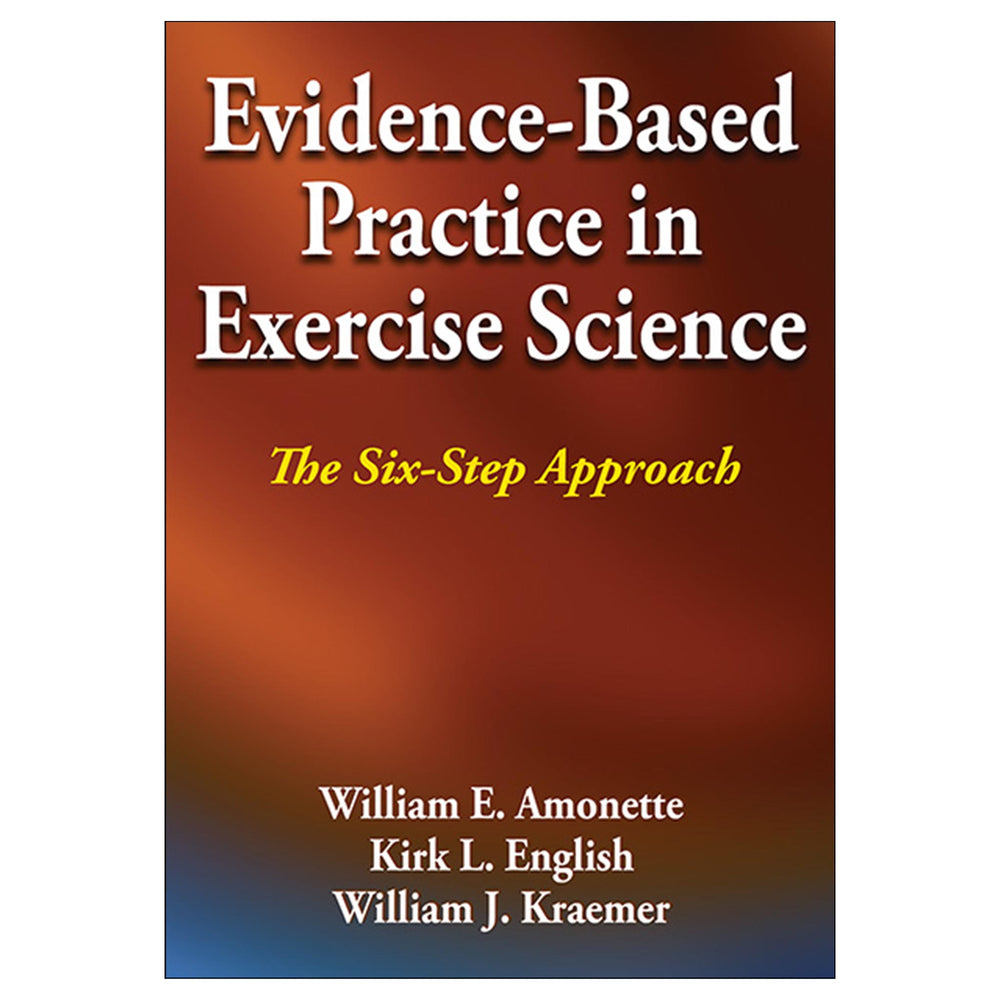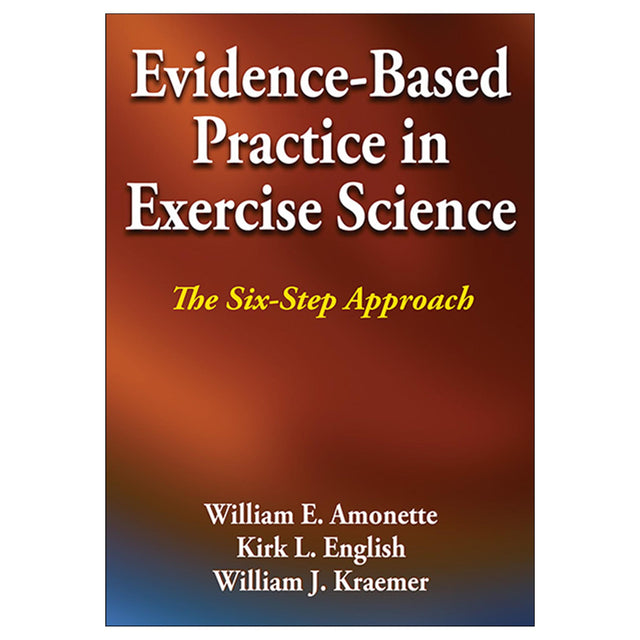Evidence-Based Practice in Exercise Science
The Six-Step Approach
$94.00 USD
Exercise science practitioners have access to mountains of research findings, expert opinions, novel techniques, and program plans via blogs, fitness magazines, conference presentations, and peer-reviewed journals. To facilitate effective practice, practitioners must sift through this information and retain only the best evidence to form a sound base of knowledge. Evidence-Based Practice in Exercise Science: The Six-Step Approach equips readers with the basic skills and competencies for discerning the value of scientific research. Using a methodical approach, students and professionals will learn to identify appropriate evidence to support novel interventions and avoid counterproductive or dangerous information to eliminate ineffective exercise options.
The authors, well-known advocates in the study and application of evidence-based practice in the field of exercise science, take the five-step method of evidence-based practice that has been established in medicine, adapt it specifically for exercise science, and expand it to embrace individuality in exercise training. The content is accessible for students in a variety of courses in exercise science curricula; those seeking certification through professional organizations; and practitioners in the fields of exercise, nutrition, sports medicine, and sport science.
This text is an instruction manual in understanding and applying evidence-based practice. The process is divided into six steps that begin with asking a question and then finding, evaluating, implementing, confirming, and re-evaluating the evidence. Readers of Evidence-Based Practice in Exercise Science will explore these aspects:
• The philosophy of science and design of scientific studies
• The use of search tools like PubMed and Google Scholar and how to rank or define the strength of the evidence
• Practical suggestions for implementing evidence-based practice in the field to better advise and serve athletes, clients, and patients
• Case studies that demonstrate realistic scenarios of how the evidence-based process may be used in a variety of sport and exercise settings
Each chapter opens with chapter objectives that provide a road map for learning, and a chapter conclusion summarizes main points and ensures understanding. The case studies cover topics including exercise prescription; exercise for special populations; nutrition and supplementation; and exercise devices, equipment, and apparel. Each case presents a realistic scenario that an exercise practitioner may experience, presents background information, formulates a question for investigation, describes a search of the literature, discusses the findings, and provides a recommendation for practice based on the best current evidence.
Evidence-Based Practice in Exercise Science is grouped into four sections that assist readers in gaining a better understanding of the evidence-based practice paradigm, learning the step-by-step method, and acquiring experience in the evidence-based approach by working through practical examples using real-world scenarios. Part I offers foundational knowledge of evidence-based practice in exercise sciences. Part II introduces the six-step method of evidence-based practice with chapters that explore each step of the process in depth. Part III presents 16 case studies grouped into chapters by generaal topics. Part IV concludes the text with chapters on disseminating and sharing knowledge and the future of evidence-based practice in exercise science.
By understanding the concepts and process of evidence-based practice, current and future sport, exercise, and health professionals will prescribe individualized programs and treatments that improve athletic performance and lead individuals toward better health. Embracing evidence-based practice will ultimately advance the field and produce optimal outcomes for clients, patients, and athletes.
Audience
Textbook for research methods or exercise programming courses that emphasize the use of evidence-based practice; supplemental text for undergraduate students in exercise physiology, biomechanics, motor behavior, nutrition, strength and conditioning, and athletic training courses. Reference for professionals in exercise, sport, health sciences, and nutrition fields.
Part I: Overview and Historical Background of Evidence-Based Practice
Chapter 1. The Need for Evidence-Based Practice in Exercise Science
Evidence-Based Practice in Action
Defining Evidence-Based Practice
Applying Evidence-Based Practice in Exercise Science
Team Approach to Evidence-Based Practice
Becoming an Evidence-Based Practitioner
Conclusion
Chapter 2. The Process of Evidence-Based Practice
The Importance of Evidence in Exercise Science
Applying the Five Steps of Evidence-Based Practice
The Case for Evidence-Based Practice
Criticisms of Evidence-Based Practice
Conclusion
Chapter 3. Philosophy, Science, and Evidence-Based Practice
Epistemology
Epistemology of Modern Science
The Paradigm of Evidence-Based Practice
Conclusions
Chapter 4. Sources of Evidence
Sources of Knowledge
Types of Evidence
Conclusion
Chapter 5. Reading and Interpreting Research Evidence
Consumers of Research
What is Research?
Components of a Research Paper
Steps to Critically Reading Research
Conclusion
Part II: The Six Steps of Evidence-Based Practice
Chapter 6. Developing a Question
Question Development Areas
Types of Questions
Components of a Foreground Question
Conclusion
Chapter 7. Searching for Evidence
Searching for Preliminary Information
Finding Peer-Reviewed Sources
Searching a Research Database
Conducting a Secondary Search From Reference Lists
Conclusion
Chapter 8. Evaluating the Evidence
Why is it Important to Rank the Evidence?
Critically Appraising the Literature
Levels of Evidence
Conclusion
Chapter 9. Incorporating Evidence into Practice
Translating Research Into Practice
Deciding When to Act on Evidence
The Influence of Evidence
Implementing Research-Based Evidence
Conclusion
Chapter 10. Confirming the Evidence in the Individual
Generalizability of Research
n-of-1 as a Model for Confirming the Evidence
Confirming the Evidence in the Individual in Exercise Science
Basic Principles in Testing and Measurement
Deciding to Continue or Discontinue an Intervention
Collaboration in Evidence-Based Practice
Conclusion
Chapter 11. Reevaluating the Evidence
Prompts to Reevaluate
Techniques to Stay Current
Conclusion
Part III: Case Studies in Evidence-Based Practice
Chapter 12. Exercise Prescription
Case Study 1: Strength Training and Cycling
Case Study 2: Static Stretching and Soccer
Case Study 3: ACL Injury Prevention in Female Athletes
Case Study 4: Single Versus Multiple Sets for Strength Improvement
Case Study 5: Models of Periodization
Conclusion
Chapter 13. Exercise for Special Populations
Case Study 1: Resistance Exercise and Functional Outcomes in Those Who Are Elderly
Case Study 2: Exercise and Cancer Cachexia
Case Study 3: Exercise and Traumatic Brain Injury
Conclusion
Chapter 14. Nutrition and Supplementation
Case Study 1: Creatine Monohydrate and Cycling
Case Study 2: Caffeine, Coffee, and Performance Enhancement
Case Study 3: Protein Intake for Endurance Athletes
Case Study 4: HMB and Strength–Power Athletes
Conclusion
Chapter 15. Exercise Devices, Equipment, and Apparel
Case Study 1: Chains
Case Study 2: Vibration and Muscle Strength and Power
Case Study 3: Instability Training and Muscle Strength
Case Study 4: Minimalist or Barefoot Running and Running Economy
Conclusion
Part IV: Integrating Evidence-Based Practice into Exercise Science
Chapter 16. Disseminating and Sharing Knowledge
Local Discussion and Networking
Conferences
Formal and Informal Publications
Conclusion
Chapter 17. The Future of Evidence-based Practice in Exercise Science
Ability, Judgment, and Evidence
Review of the Rationale for Evidence-Based Practice
The Future of Exercise and Science
Spreading the Evidence-Based Practice Philosophy
Working With Scientists
Becoming an Evidence-Based Practitioner
Conclusion





